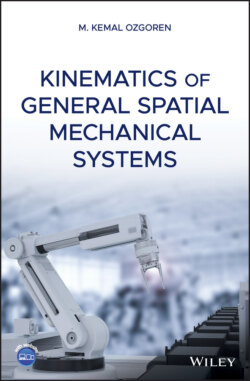Читать книгу Kinematics of General Spatial Mechanical Systems - M. Kemal Ozgoren - Страница 59
3.5 Expression of a Transformation Matrix as a Rotation Matrix 3.5.1 Correlation Between the Rotation and Transformation Matrices
ОглавлениеSince the reference frames and are both orthonormal, right‐handed, and equally scaled on their axes, it can be imagined that is obtained by rotating as indicated below.
(3.54)
The rotation of into is actually achieved by rotating the basis vector of into the basis vector of for all k ∈ {1, 2, 3}. That is,
(3.55)
As indicated above, the considered rotation is achieved by means of the rotation operator rot(a, b), which is shown below with its angle‐axis detail.
(3.56)
Consequently, for k ∈ {1, 2, 3}, the basis vectors of and are related to each other as follows according to the Rodrigues formula:
(3.57)
Suppose that the rotation of into is observed in a third reference frame . Then, the following matrix equation can be written in in correspondence to Eq. (3.57).
(3.58)
In Eq. (3.58), is the rotation matrix that represents the rotation operator rot(a, b) in . In other words,
(3.59)
By introducing the transformation matrices and , Eq. (3.58) can also be written as shown below.
(3.60)
Recalling that and , Eq. (3.60) can be manipulated into
(3.61)
Equation (3.61) implies that or
(3.62)
On the other hand,
(3.63)
Therefore, in either of the two special cases with and , Eq. (3.62) leads to the result that
(3.64)
However, unless or , Eq. (3.62) implies the inequality that
(3.65)
